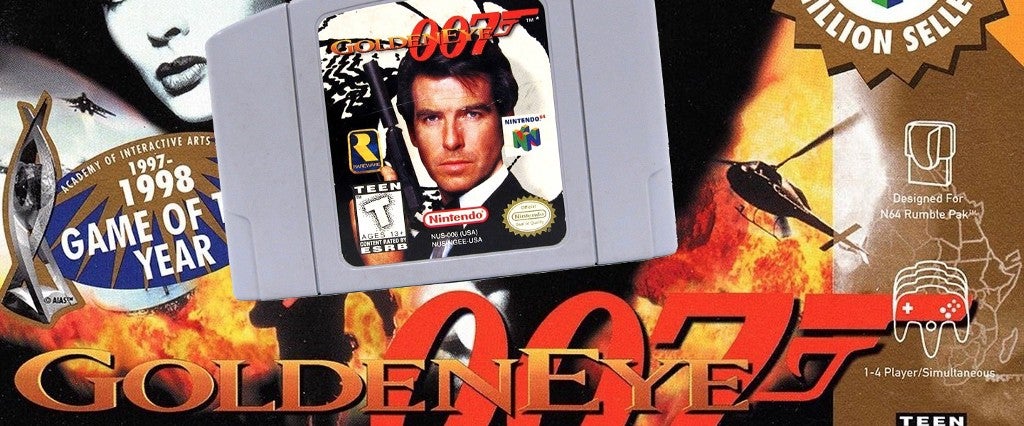The Nintendo 64’s GoldenEye 007 — or GoldenEye 64, as it’s often known — is seen as one of the system’s all-time classics. Aug. 25, 2018, will be the game’s 21st birthday (allowing Bond to finally taste one of his revered cocktails), so we reached out to the people who played, reviewed and created the game to see how it all came together, way back in 1997. From the multiplayer being added as an afterthought to the game almost having every Bond actor ever, the game you and your buddies logged hours on — paintballing in the Stack or shooting Boris in the balls — was almost something very, very different.
Just Another Film License
GoldenEye 007 was originally planned to be a 2D, single-player side-scrolling game, much like Donkey Kong, another game that British developers Rare were producing at the time for the SNES. However, lead developer Martin Hollis suggested it be a 3D first-person shooter for the Nintendo 64, a system and technology that didn’t even fully exist yet. He got his way, and assembled a ragtag team of new-to-gaming developers to begin working on what was expected to be “just another film license” game — games that typically rode the movie’s fame, but didn’t prove to be smash hits, critically or commercially.
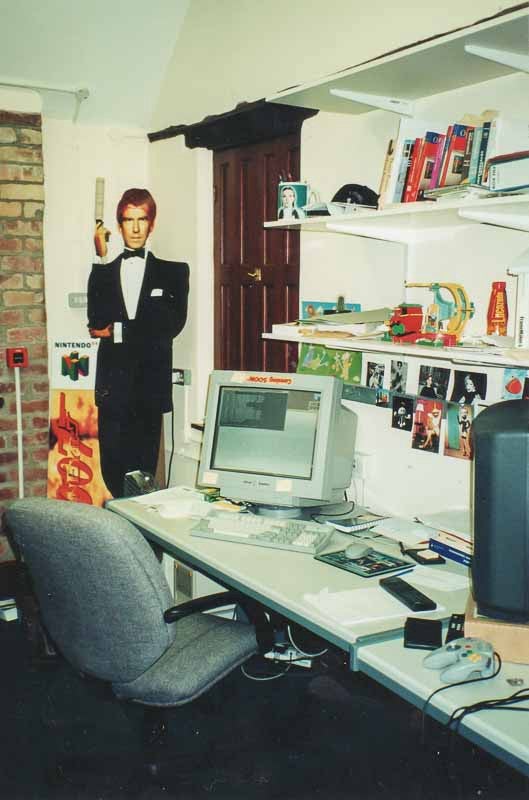
Chris Kohler, features editor at Kotaku: By the time the 64 came out it was pretty obvious to everybody, especially by 1997, that Sony was going to be crushing everyone with the PlayStation. Nintendo had made some serious mistakes, like going with cartridges instead of the CD-ROM drive. [Since] Nintendo was stuck with doing cartridges, it became important for them to get as many game titles out as it could and flood the market.
In addition, for some reason, the 64 did significantly better in America than it did in Japan, so there was demand for games that were oriented toward American audiences. That’s where Rare stepped in and became a Nintendo powerhouse, cranking out so many games that had an American aesthetic to them, which powered the console’s library at a time when Nintendo really needed it. So that’s the environment into which GoldenEye was born.
Karl Hilton, lead environment artist: The early concepting for GoldenEye involved myself, Martin Hollis and Bea Jones going down to the film set in Leavesden for several days to take photos of everything we could find, from props and costumes to all of the actual film sets and even models and miniatures. I took hundreds of photos on 35mm film — we used them as reference for all of the in-game art.
Mark Edmonds, gameplay and engine programmer: It was a cool experience, never having been to a movie set before. Pierce Brosnan might have been in the canteen when we were having lunch, but we didn’t see him in any scenes acting on set.
David Doak, developer: There was no paradigm for what games would be in 3D. Everything was coded from scratch, particularly making a 3D game on a completely new piece of hardware [like] the N64. Literally, the engine was built by sitting down with graphics textbooks and figuring out every step of the way. Since we had this very broad license, we were pretty much allowed to use anything from the Bond universe and gathered all the data points we possibly could.
Hilton: We were even given the set blueprints so we could plan out the levels based on the actual set designs, and a very early version of the film script so we knew all the characters and plot developments. Also, all of the international locations the film would be using.
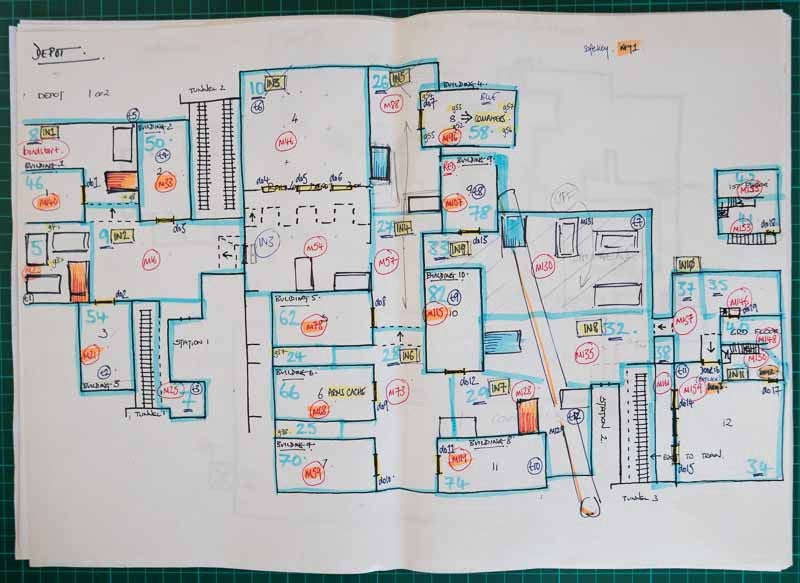
Mitchell K., purveyor of GoldenEye 007 modding site GoldenEyeVault.com: The solo mode is so precise in the modeling and texturing they did to match the movie sets — even the Russian text on doors and barrels match the movie exactly. I used to occasionally watch the movie, then immediately want to play the game and see how it matched.
Doak: A really obscure aside — there’s a character in the film, Jack Wade [played by Joe Don Baker]. He’s like, a guy who helps Bond when he’s in a pinch. And he’s the only guy in the film we weren’t allowed to use his likeness. It’s a really minor part in the film, but I remember we couldn’t use him in the game because the actor hadn’t signed off on the release! He’s the only character who doesn’t appear in the game.
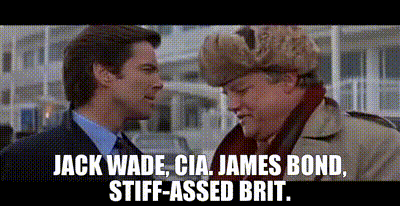
Making the Game
When the development team began working on Bond, the Nintendo 64 didn’t yet exist, which made development a double-edged sword: Unsure of the limits on 3D gameplay, they didn’t know what was possible and what wasn’t. But the team was young and hungry to prove themselves, and because the N64 launched after the GoldenEye movie, they had a very flexible deadline. It was the perfect combination of innovation, hustle and scraping bits together to make it work. What emerged was a masterpiece that changed the industry and set many standards still seen in first-person shooters today.
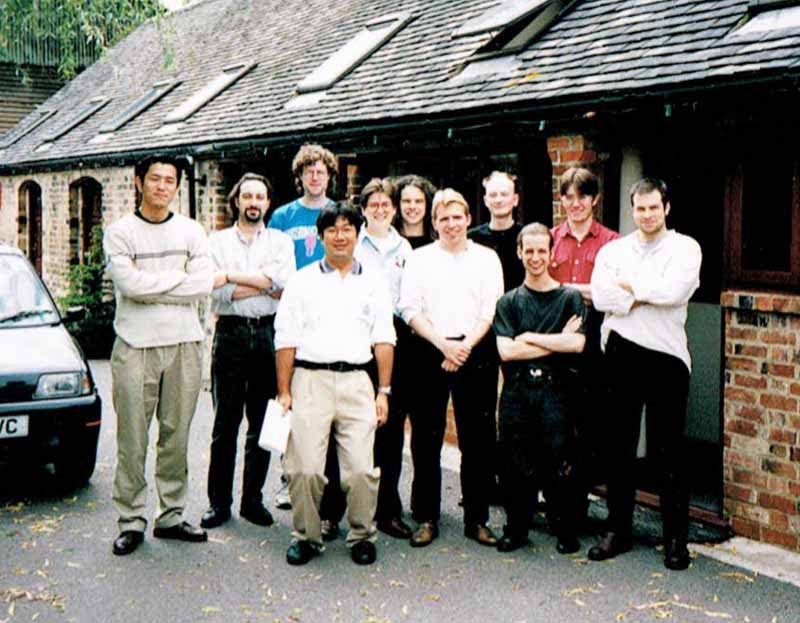
Doak: By today’s standards, it was a tiny team. It was less than 10 people, and we were all in our late 20s/early 30s and mostly single. Thus, we didn’t have big commitments outside of work, so we could spend a lot of time working — and we did. In the last months of the game, it wasn’t unusual to be doing 100-hour weeks. We all kind of suffered from the imposter syndrome, in that we all thought we were really lucky to be having a chance to work on it at all. We were really worried that it wouldn’t be any good, and we’d let everyone down.
Hilton: For all of us, it was our first job in video games development specifically. We were basically a bunch of university graduates who had far more enthusiasm and ambition than actual game development experience. We knew we wanted to make a shooting game with a first-person perspective, and we all loved playing multiplayer games like XPilot, DOOM, Bomberman and Battle Zone, and spent a lot of time and money at the local Sega World arcade playing Daytona USA and Virtua Cop, which was an early inspiration for GoldenEye.
Doak: The N64 controller wasn’t finalized when we started, so we used some kind of hacked Sega Saturn controller cobbled together. It was very much, “Put some stuff together, see how it feels, is it capturing the story and do we need extra stuff added in?” Then I’d go back to Mark Edmonds and say, “If we could do this, it’d be better.” And Mark would fiddle about and say, “Well, there aren’t tools for doing that, so try to go and build it from scratch.”
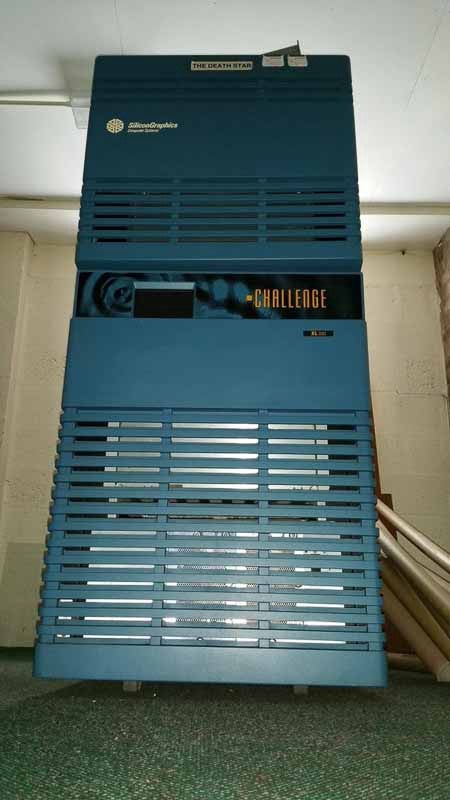
Edmonds: The hit-test and detection-work probably came about as we originally started making the game in the style of the arcade games Virtua Cop and Time Crisis, where aiming and hitting the right thing was a crucial part of the gameplay. Martin Hollis wrote the code for hit-testing, then I took it and kind of bodged it so it could be used for shooting tests as well. Then I added on some simple cuboid hit box testing on the character limbs and other props, like crates, so you could actually shoot and destroy stuff.
Doak: It was just a very organic process — there actually was a gameplay outline, but I didn’t see it until 2015! There wasn’t some big grand design that everyone had to strictly follow. If there was an idea that someone had, and it was convenient to do, we ran with it. We would build things and play it, and look for problems. It was very iterative. For instance, all the non-essential characters in the game are actually Rare employees and those of us on the dev team. I first put myself in as Dr. Doak, the double-agent scientist in the Facility, as a laugh. But then the team realized it was easy to do, so that’s what we did.
Edmonds: In some of the original testing, there were huge gouts of rendered blood boiling out of enemies when you shot them. So this got toned down a lot to just brief flashes of red. There was some worry about leaving the red markings on enemies where you had shot them, but luckily that stayed in. There was also some attempt with the front-end sequences to impart a bit of a filmic feel — to show that all the characters in the game who you’re going round shooting aren’t actually real, and they aren’t actually dying, they’re just characters in a video game!
Hilton: Yeah, Nintendo of Japan was concerned about the amount of killing that happened in the game, and made some suggestions about reminding people that James Bond was fictional, that this was based on a film. [Martin Hollis previously told The Guardian that an idea was floated to have Bond tour a hospital, shaking hands with all the people he shot.] It certainly wasn’t a typical “Nintendo” game for that period on the N64 console. There was a definite realization that console gaming was getting more mature, and this was part of the growth of video games in this area for Nintendo. It certainly was a counterbalance to the Mario games!
Edmonds: Plus, it was important to get a teen rating so as many people as possible could buy and play the game.
Doak: Another idea we had that was never really serious: What happened was that all the N64 controllers had that slot in them, and everyone’s always wanting there to be some reason for some arbitrary piece of hardware. So it was like, “Can you use this in GoldenEye?” All of our reference for guns was watching [movies], so someone said, “Well, what if you slam in the thing to reload,” because it could detect when it was plugged in. But when we trialled the reload, it was rubbish, so we didn’t do it, and it actually became a big joke.
The Legendary Multiplayer (That Almost Didn’t Happen)
GoldenEye 007’s multiplayer mode was one of the many ideas that wouldn’t have happened if everything went according to the original timeline of launching with the Nintendo 64 and the movie. Most first-person shooters only existed as single-player games, and GoldenEye 007 was expected to follow suit. But when the team found out there would be four controller ports, they wondered what a multiplayer mode would look like: Without telling Nintendo, they went to create it on their own. The more they developed (read: played) it, the better it became.
Right before launch, the team decided to show it to management and Nintendo: The rest is a rich history of utterly hooked players nearly melting GoldenEye 007 cartridges into their consoles with hours of multiplayer on end, paintballing dicks onto the Aztec walls and relegating those deemed “Most Cowardly” to sleep on the floor.
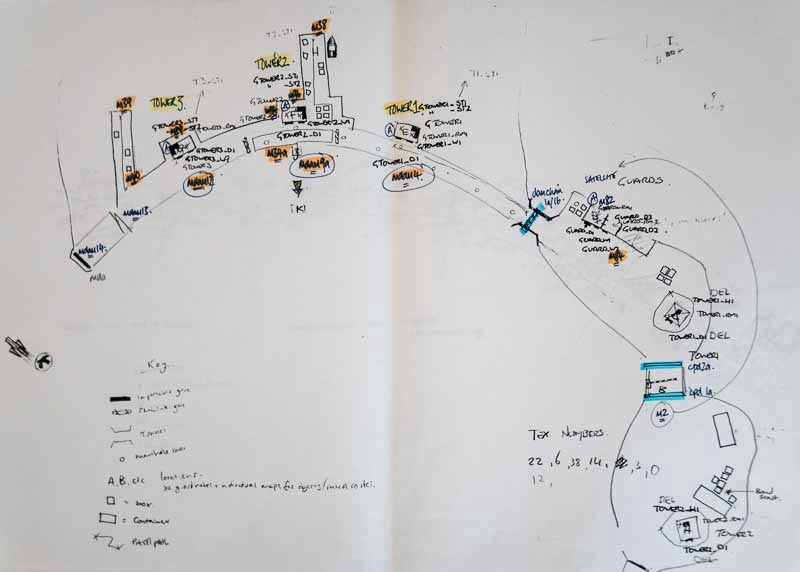
Kohler: At the time, single-player mode would’ve been the thing that was concentrated on, because that’s what people did with their game consoles. In general, game consoles had two controller ports, but the Nintendo 64 changed things by making the four ports standard. That enabled out-of-the-box four-player parties, because you didn’t need to buy an expansion multi-pack, so developers were more likely to include four-player functionality.
Doak: The multiplayer mode, which is now seen as critical for its big success, was for a long time just a wish-list thing, not a thing that we were definitely going to have. The N64 had four controller ports so it invited the idea that you’d have four-player split screen, but we were only going to program a multiplayer mode if we had time.
Edmonds: I remember doing the code to handle the four-player split screen rendering before we’d actually been given the go-ahead to add in a multiplayer mode. That way when the decision was being made on whether to include it, I could say, “Well, we already have a split-screen mode working — it would be a shame not to use it!”
Doak: Steve Ellis, another programmer, was finishing off the work he was doing on the main game, and Martin told him, “Okay, you and Duncan just go, we’ve got, whatever it was, three or four months left, see if you can get the multiplayer working before the deadline…” We always knew it was going to be clunky, and they hammered away at it as a tiny team of two people.
Edmonds: We got a basic demo mode going, and it was fun. So we all decided it needed to be turned into a proper part of the game with different modes and scoreboards and that kind of thing. I don’t think I ever thought of it as a game-changer at the time, but we all enjoyed playing it ourselves and had lots of fun developing it, so that was enough.
Doak: When it was finally revealed to management and Nintendo that we had it working, they were very pleased.

Hilton: Personally, I always loved Golden Gun in the Complex, partly because I liked the speed and accuracy required for Golden Gun, and partly because the Complex was one of my levels and I liked the layout a lot. Also, I added all those “cheaty” little invisible cubby holes in the Complex and didn’t tell the rest of the team for a few days. It was the only way to win, and I’m not even sorry.
Edmonds: Different people will have different favorites, but personally, I like grenade launchers in the Temple, or any level for that matter. Nothing better than blowing someone up at range or round a corner. And in close quarters it can become mayhem!
Mitchell K.: I play as Xenia in multiplayer, because she was fun in the movie. My favorite multiplayer to play is basement, License to Kill, or 2 v 2 Golden Gun in Facility. License to Kill, Basement, Pistols: Doesn’t get much better than that!
The All-Bond Deathmatch
A common debate among Bond movie diehards is over who is the superior Bond: Roger Moore, Sean Connery, Pierce Brosnan, Timothy Dalton, or for true iconoclasts, George Lazenby? (Remember, this game came a good nine years before Daniel Craig’s muscled sourpuss take on the character.) With such a wide-reaching license on the Bond universe, the development team figured, why not let this conundrum play out in GoldenEye 007, by programing the former Bonds into the game?
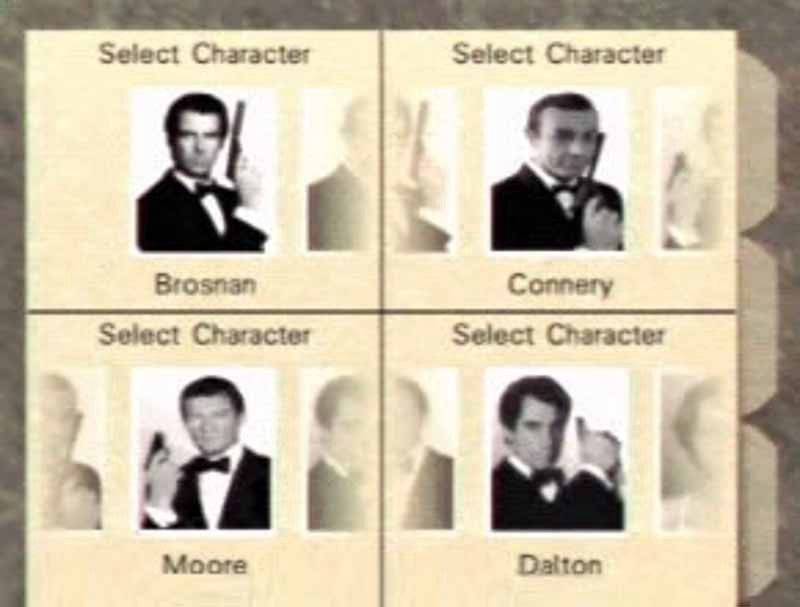
Hilton: We were working under the assumption we could use anything from the Bond universe, so we raided the previous movies for much of the multiplayer content of the game.
Doak: That’s why Oddjob [who originally appeared in 1964’s Goldfinger] is in the game! People always ask me why he’s in the game, and it’s because he’s in the Bond universe, and he’s short because he’s short in the movie. But beyond other characters, the natural thing for us to do was to make it so that you could play as any one of the Bonds — or well, we picked four: Connery, Moore, Dalton and Brosnan. The idea was you could play with them in multiplayer, as unlockable characters. And we liked the idea of playing through the game a second or third time as Roger Moore or Sean Connery. You wouldn’t see it apart from the cutscenes.
But then, I remember it was quite late — because the day the MGM studio executives came, I was setting up the Aztec level with Baron Samedi [who originally appeared in 1973’s Live and Let Die] in it, and they were quite pleased we had Samedi in it because he was an iconic character. So we showed them we had all the Bonds… Well, soon after that we got a memo saying we couldn’t have all the Bonds, because only the GoldenEye actors had signed off on the digital rights to their likeness to be used in games, not the older movies.
Edmonds: So in order to represent Sean Connery, Roger Moore or Timothy Dalton in the game we would have needed to do a deal with their individual agents to get the rights. And unfortunately, it would have been too expensive.
Doak: They particularly said Connery would want money, and then if Connery wanted money and got money, the others would want money as well. So they got taken out.
Edmonds: Nintendo’s legal department also got worried about lawsuits from various gun manufacturers if we used real gun names. We had to change them to made up ones, which was disappointing.
Hilton: So the whole team just started making up names that sounded appropriate for the guns — except for the Klobb, which we named after Ken Lobb, who was one of the most senior guys at Nintendo at the time and was a big supporter of the game within Nintendo.
Doak: The Klobb, famously, doesn’t shoot straight. I remember Ken came in excited one day and said, “You guys! You named a gun after me!” We told him, “That’s the good news; the bad news is we named it after you because it’s loud and inaccurate.”
Edmonds: These days, lots of games seem to use the real gun names without any problem, but back then the situation was untested.
Doak: Anyway, all the Bonds were in the game, but we had to make it so we couldn’t use them in the final version. We decided the best way to send them off would be a deathmatch — first to 100 kills, just using all the Bonds. It was a marathon deathmatch, probably a couple hours or something. It was me, Martin, Duncan and Mark — and Mark won with Roger Moore by one kill. It’s a shame really, it would’ve been so fun to let people play out their arguments with all the Bonds that way.
Cheating with Oddjob, the Slapping ‘Karate Chop’ and All the Random Modes
With such an obsessive group and a flexible deadline, the members of the development team were able to sneak in little cheats and random ideas along the way. Paintball mode, Oddjob, big heads and the “karate chop” were all funny quirks added along the way that ended up staying in, much to the team’s delight. In any other game, with a strict gameplay outline and deadline, such ideas would never come near the final product, but again, the stars aligned for GoldenEye 007.
Doak: The last year of development we were always trying to finish the game as soon as we could, but the date would get pushed a little bit, then pushed a little bit more, so we kept tinkering and adding new things.
Hilton: A lot of the cheats were added by the code team of Martin and Mark, along with Dave and Duncan. I do remember we enjoyed playing a deathmatch with the oversized heads ’cause it was just so funny.
Edmonds: I’m not sure who thought of all the different types of cheats, but it probably includes ideas from everyone on the team. I think different programmers added in different cheats: I added the Big Head mode as I wrote all the animation software, and it’s probably my favorite as it looks so ridiculous.
Hilton: The karate chop was supposed to be a slightly more lethal looking martial arts style “chop.” In the end, we all found the slightly “slappy” nature of it funny — it definitely appealed to the slightly immature sense of humor that the whole team shared. So we kept it like it was and implemented “Slappers Only” mode [“slapper” being a British slang term for a promiscuous woman].
Edmonds: Ah yes, the karate chop. It somehow acquired the name of “slapping” during development. Indeed, the multiplayer mode that only allows you to use this attack is called “Slappers Only,” which I think is where everyone else gets the name from.
Hilton: We all thought it was kind of cheating when we were play-testing with Oddjob [due to his short stature, the auto-aim of the weapons goes above his head], but it was too much fun to take out and there was no impetus from any of us to change it. It’s clearly become part of the culture and folklore of the game — I noticed playing GoldenEye as Oddjob was mentioned in Ready Player One, so ultimately, I think it’s fine.
Edmonds: It’s definitely cheating to play as Oddjob! But that can just add to the fun when you’re all sitting there next to each other and berating/poking/hitting the person who chooses him. Personally I like to pick Jaws [who originally appeared in 1977’s The Spy Who Loved Me] and then beat the person with Oddjob just to show them! We could have put something in to stop this blatant cheating, but why not just let players decide on their own rules?
Mitchell K.: Oddjob is cheating: He is banned. That said, I have only played with a caliber of people who would never consider choosing him, so it has never been an issue.
An Uneasy Release
Finally released a year after the launch of the N64 — and two years after the movie! — the team (and Nintendo) didn’t know what to expect of the reception. On one hand, they’d developed a lot of groundbreaking features for a first-person shooter; on the other, first-person shooters weren’t really their own genre yet, nor was four-person multiplayer. Little did they know the game would go on to sell eight million copies worldwide, win all five categories it was in at E3, and Console Game of the Year (among four more AIAS awards), changing the gaming landscape forever.
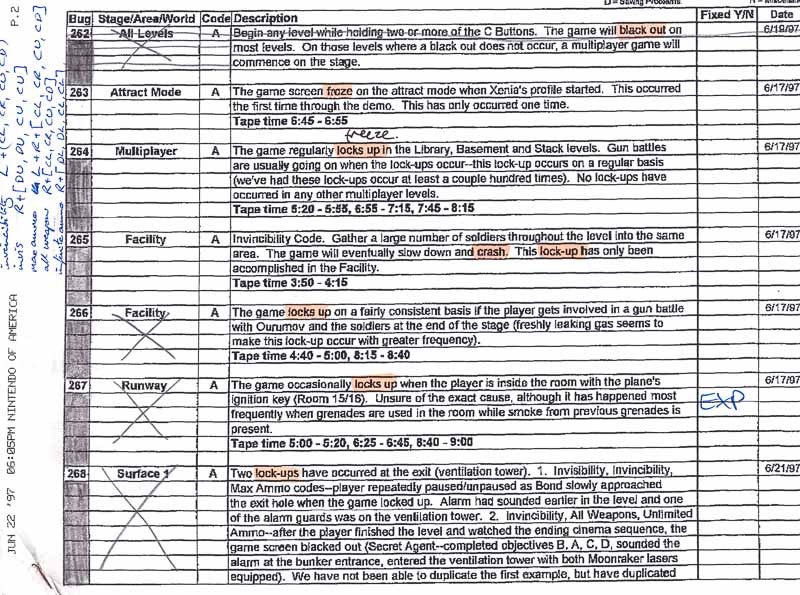
Kohler: Until 1997, people referred to first-person shooters as “DOOM clones” — the same way people today look at every battle royale game that comes out and, instead of witnessing the birth of a new genre, they look at it and say, “Oh, somebody else is copying PUBG.” Eventually, “first-person shooter” entered the lexicon and people realized it’s its own genre of game, not just a copy of DOOM. You have to wonder if the release of GoldenEye around that time had something to do with it. DOOM had deathmatch, but GoldenEye brought that to consoles.
Edmonds: The multiplayer contributed massively to the overall success, as you could just go on playing and playing and playing. And the friends you played with would then go and play the game with other friends, helping to spread its success. It was amazing, after the game’s release, to see how well it did in the rental charts for such a sustained length of time. That must have been due to the multiplayer and how long you could keep playing it and having fun.
Kohler: Effectively GoldenEye, even if it wasn’t technically the first FPS on consoles, was the birth of having four people, each holding a controller, sitting in front of the game console in front of the TV playing a first-person shooter deathmatch, instead of deathmatches over the internet, alone on computers or LAN parties. That was a major shift in terms of how people interacted with game consoles
Hilton: We were all surprised by how successful it turned out to be, as we were all a little uncertain of the final game, mainly because there was so much we still wanted to implement and change. We all felt it could have been better. Initially, I think Nintendo only made around 1 to 2 million cartridges, and we kept hearing stories of how people were searching for the game in shops that had sold out. We all thought we’d missed the chance to sell big numbers! Nintendo reacted quickly and got more games in the shops — at that point the sales took off again, which was a huge thing for us as a team. It was great to see the enthusiasm of all the Nintendo fans for the game.

Mitchell K.: At the time, games were expensive, and you’d mess with a game and have fun with it for months before getting a new one. You did a lot of game rentals from Blockbuster and playing games other people had, and then buying only the best games for keeps. I probably saw the game in Nintendo Power, but I wasn’t too aware of the game before launch, actually. My first experience was playing Complex in multiplayer for a short time, and with a confusing level layout, I didn’t really like it. Then a couple weeks later, I saw Control in single player on a large projection screen … and was stunned at how amazing it was, and never looked back. Of course, I had trouble getting GoldenEye during the holidays because it was sold out everywhere. I didn’t get it until January and then I never stopped playing.
Derek Clark, GoldenEye 007 speedrunner: I was a hawk at Blockbuster in those days. There weren’t many N64 games, and new ones were trickling in. When a decent one launched, me and several friends were usually onto it quickly. I’d played Turok previously and wasn’t a huge fan, but GoldenEye definitely passed the “Blockbuster test” — I was ready to buy it after one rental. It was the most enjoyable multiplayer of any N64 game up until that point. Human vs. human FPS was just getting going online, with most people still limited by dial-up internet, so GoldenEye was our first exposure to this popular type of gaming.
A Cherished Legacy
As long as the Nintendo reigned supreme, so too did GoldenEye 007. While other games rose and dipped in popularity, GoldenEye 007 was a mainstay at sleepovers and college dorms, as people logged countless hours double-fisting RCP-90s and blowing up the traitorous Trevelyan in the Facility. Eventually, the Xbox came along — and with it, Halo — but even as gamers migrated onto the next console, the love for Rare’s game persevered.
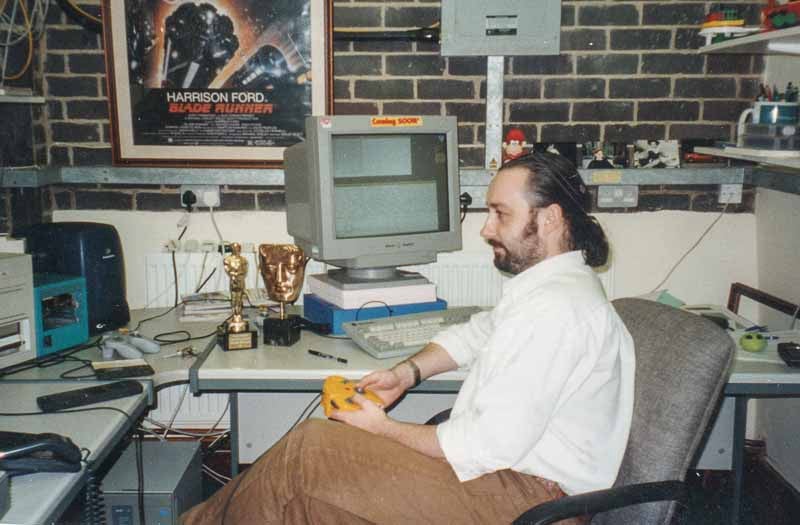
Doak: Its recognition and enduring legacy, a lot of that is luck, the kind of perfect storm of some things that came together. It was significant because it was a great four-player split-screen game on N64 — there was no console FPS that had such a compelling single-player game at that stage, especially given 3D was totally new.
Kohler: Where GoldenEye stands in the pantheon of games, it’s incredibly important. It led directly to Halo, and that whole era of people coming together — an older audience, quite frankly, young adults, all bringing their controllers over and gathering around one console. The era — which was short-lived — of the console first-person shooter party was kicked up by GoldenEye. When I was in college, I think sophomore year, there were two groups of friends who had two double rooms in a dorm. They all piled four of them into a single room for sleep, and turned one room into “the chill room,” which was literally just beanbags, an N64, four controllers and GoldenEye. It was a whole thing.
Mitchell K.: GoldenEye lives on mostly because of nostalgia, at least for those of us still around from 21 years ago. The game is no doubt a classic and it holds up well today gameplay-wise, but new gamers have trouble with the low amount of polygons used for the models. The canceled XBLA remake would’ve really given us a resurgence of popularity and removed the graphics from getting in the way of people enjoying the game. That said, there are new people on the forums who didn’t play the game originally, so there’s more than just nostalgia. But for a lot of us, it’s that.
Hilton: I’ve been blamed many times, over the years, for failed degrees or underachieving exam results caused by too many late night GoldenEye deathmatch sessions. It’s great to know you’ve made a lasting impression on people’s lives!
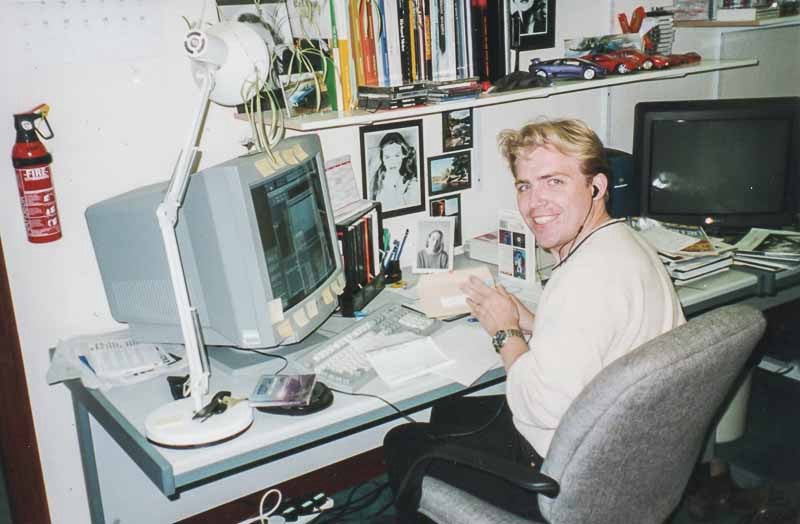
Clark: Speaking just in terms of solo mode, the gameplay was excellent. Rare’s attention to detail was impeccable: They properly recognized that 3D was a way to escape the linear feeling of most games. You could spend half an hour trying to finish Bunker, unable to locate a key that’s been sitting on the ground since minute three or so. This was the closest thing to virtual reality I’d encountered.
Doak: It’s been interesting to me in the last few years, as various GoldenEye anniversaries come up, there’s always the memory that people have about the game. It’s like, “GoldenEye was so important to me because I played it to death,” and then they add, “With my friends or my brothers or my sisters or whatever.” So in a way, it hooked into a lot of people’s childhood memories of playing with their friends. That’s why I love good ol’ couch-based multiplayer — I’ve never had as much fun playing online as I’ve had playing with people in the same room. The game’s happening and everyone’s invested in that, but all the trash talk and messing around, you know, it’s a good social experience that games today are missing.
A Newfound Future
GoldenEye 007 has taken on a new life with the next generation, thanks to Twitch and live-streaming gameplay, becoming a mainstay of the speedrunning world (where players upload videos of themselves racing through levels as fast as possible, trying to beat others’ record times). But despite the reports that a remake almost made it to Xbox — and not counting the very good, but very much its own game reimagining for the Wii — chances are slim we’ll ever see an updated Goldeneye 007.
Mitchell K.: Today, people play each other online using emulators, and there are speedrunners of GoldenEye, who have gained a lot of popularity lately with the rise of video-game streaming, and they do meet-ups yearly themselves. Also, I still hear of occasional local GoldenEye tournaments our members play in.
Edmonds: I’ve seen some of the speedrunning stuff on websites, and it’s cool that people can continue to play the game and perfect it. It seems a bit like getting record high scores on classic games like Space Invaders and Pac Man.
Doak: All the little glitches the speedrunning community has found! Like the controls — there is forward and strafe, but speedrunners found if you go at a 45-degree angle, you go 1.4x the top speed. So speedrunners found out to go diagonal all the time! Also, you’ll see them looking at the floor for most of the runs — looking at the floor means the game environment around them doesn’t need to render, which means it runs ever so slightly faster.
Clark: Simply put, speedrunning means: Finish the level (or the game) as fast as you can. If there are shortcuts, take them; if there are glitches/exploits, use them. Modern speedrunning has come to emphasize the time it takes to “beat the game,” as defined by pressing “start” to the moment the credits roll. GoldenEye speedrunning by individual level has been popular since the game came out, however.
Doak: We inadvertently invited speedrunning from very early on, because we had the timed unlocks.
Clark: Finishing the level faster than the target time unlocked a cheat. The harder the target time, the more awesome the cheat mode: Turbo mode, Bond invisible, invincibility, unlimited ammo — essentially keys to enter God Mode, a means to explore the game in unimaginable ways. Personally, the challenge itself got me addicted: It was a very dynamic game for speedrunning, and the target times were a clear invitation to prove yourself. Facility 00 Agent’s target of 2:05 was the legendary measuring stick. The-elite.net, the home of GoldenEye speedrunning, has been tracking records since 1998. Remarkably, the game has more active speedrunners right now than at any point in the past.
Doak: That community continues to use GoldenEye as one of its pillar games. It’s phenomenal the life GoldenEye has had beyond its intent.
Kohler: I don’t think it makes sense to remake the game, the designs of the levels — to take that and just slap a new coat of paint on it would be strange. That said, if Nintendo were to release a Nintendo 64 Classic, like they did last year with the SNES Classic that costs $80, I could see them putting the original version of GoldenEye onto it, in hopes of getting people who played it back in the day to go play it again, and maybe sell a whole bunch of retro hardware. Otherwise, it’s such a product of its time — this sort of beautiful moment in gaming history — and not something you can recapture, because if you look too closely at it, it’s not going to hold up in the modern day.
The thing is, Nintendo never followed up with something that would be as good as GoldenEye. Nintendo decided to sell its stake in Rare to Microsoft, and instead of really launching GameCube with a FPS experience that grabbed the GoldenEye audience, everyone who played GoldenEye moved over to Xbox for Halo. In hindsight, I would’ve said take Perfect Dark [created by the same development team], move it to the GameCube, make it a launch-day title and then Perfect Dark could’ve gone up against Halo, and then who knows? The game industry could have looked very different had they made that move.
But that’s not what they did, so GoldenEye became this very interesting flash in the pan.
